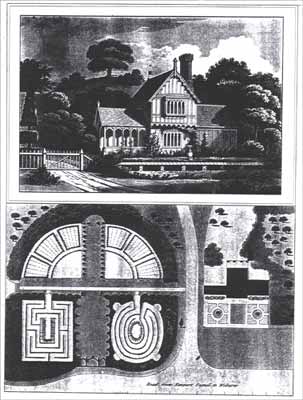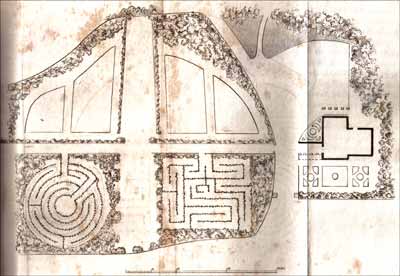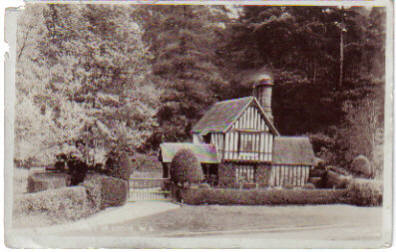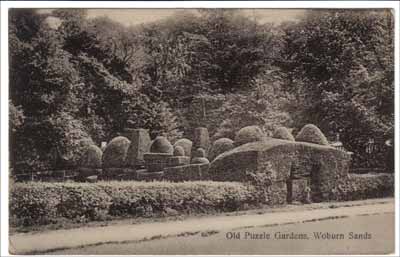Queen Victoria and Prince Albert visit Woburn Sands in 1841
Queen Victoria had only been on the throne a few years when she paid a visit to Woburn Abbey in 1841. The Duchess of Bedford had been her “Lady of the Bedchamber”, a personal attendant, since her accession in 1837, and they were great friends.
On Monday, July 26th, the Royal entourage took over four hours to travel from Windsor, and was welcomed by some 8-10,000 people gathered in the Abbey grounds. There was such a crush of crowds, that when the children of Woburn School arrived, led by Rev. Mr Hutton, there was nowhere for them to stand but in the gutters of the road, where they were in danger of being trampled by horses or run over by carriages, so the Duke arranged for them to stand on the terrace of the Abbey itself. A cold collation tea was laid on for 200 tenants of the Duke on his tennis courts, where Prince Albert, the Duke of Wellington and the Duchess of Bedford went from table to table to meet them all.
As well as press reports, the Queen herself kept a diary of her daily activities, so we know they had a large social dinner on Monday. Giovanni Puzzi provided the music for the occasion (his score for the event, “Composto in Occasione della visita della Regina al Castello di Woburn del Duca di Bedford”, is currently (September 2015) for sale for £2800.)
Later, a group of local dignitaries gathered outside the open dining room windows and sung a new version of “God Save the Queen”, with words penned by the Woburn poet George Castleden, [see “George Castleden, Poet of Woburn 1804-1884” on the menu, left] along with a firework display and ‘fire balloons’, which thrilled the crowds.
On Tuesday morning, the Queen was shown around the Sculpture gallery, and saw Canova’s “Three Graces”, which she thought “very lovely…”. She admired the Russell’s paintings collection and their library. They lunched at 2pm, then had a couple of hours in their appartments, letter writing and dealing with affairs of state, before the Royal party and their hosts reconvened and went out. This is what Queen Victoria recorded in her diary for that afternoon:
“Before 5, I drove out with the Duchess of Bedford, the Dowager Duchess, & the Duchess of Sutherland, Albert, riding with the Duke of Bedford, & Lord De Grey, the other Ladies driving. A crowd, of good, loyal, but rather troublesome people rode with us, part of the way & pushed & jostled. It was as if we were hunting. We drove along a very fine extension evergreen drive, between firs, fines, & laurels. Drove through the town of Woburn, on our way home. It was crowded with people, who again rode & ran with us.”
As you can see, Woburn Sands is not mentioned by name, and we were unaware of any firm connection to Woburn Sands, until I found this paragraph tacked on to the end of a report about their afternoon trip in the Bucks Gazette of 31st July:

“Woburn Abbey, Tuesday – The crowd of spectators assembled in front of the Abbey today in great numbers. The Queen, in a carriage with the Duchess of Bedford, and two ladies of the court seated opposite, went to the Maze at Woburn Sands, attended by the Prince on horseback, and several of the nobility in carriages and on horseback. Her Majesty had evidently been refreshed from the fatigue of the journey experienced yesterday, and looked remarkably well.”
The maze mentioned was one beside the Henry VII Lodge, on the Woburn Road, which was built in 1811. [You can find more details about this building and its gardens under “1810 Henry VII Lodge” on the menu, left] The building became a regular feature in picture postcards in the early 20th century, and survives to this day. The mazes were later converted into a topiary garden, which also features in postcards, but the area is now just garden.


Whether the square and round mazes had actually swopped around within this time-frame is debatable. More likely one (or both) of the illustrators used some artistic licence…!
Although their destination that day was not very well covered in the press, their return trip to the Abbey in the evening certainly was. This description comes from the Northampton Mercury:
“It was soon understood that her Majesty would drive through the town that evening, and towards five o’clock Woburn presented such an appearance as we should think it never presented before, it was almost impossible to get down the street, so very dense was the crowd. Tables were ranged on the west side of the street for the tea drinking, from the Church to the Town Hall, and on the east from Mr. Dodd’s at the Post Office to Mr. Devey’s. We cannot pretend to guess at the number of women and children who sat down to enjoy this refreshment, but it was surprisingly great. The ladies of Woburn were good enough to preside at the tables, and the Rev. Mr. Hutton, among other gentlemen who formed the committee management, was indefatigable in his exertions to minister to the comforts of his humble guests. Tea was over, and the paraphernalia fortunately cleared away, when the approach of her Majesty from the north-end the town was announced. The tables were instantly converted into standing places, to the imminent jeopardy of the occupants, for many of them, not constructed for such rude uses, gave way beneath the weight so suddenly imposed upon them, and precipitated their living burdens upon the shoulders of those who occupied the less exalted but more secure position on ‘terra firma’. Her Majesty passed slowly through the crowd, amidst deafening cheers, waving of handkerchiefs and flags, and every conceivable demonstration of the most heart-felt loyalty. The royal cortege then proceeded to the Abbey, entering the Park at the grand entrance on the London road, and thus affording the multitudes who could not get into the town an opportunity of gratifying their eager curiosity, and testifying their loyal respect.”
It continues with a description of the activities arranged in Woburn to celebrate the Royal visit:
“Leaving the royal cortege on its way to the Abbey, we return to the town, where the holiday-seekers evinced no disposition to separate. Gingerbread stalls and such appurtenances of a fair had been erected, and found ample encouragement. A variety of rustic sports took place, which afforded an immense deal of amusement. The following programme issued on the occasion will afford a good idea, of the fun :-
‘Rustic Sports, in commemoration of the visit of her Most Gracious Majesty Queen Victoria, to Woburn, on Tuesday, July 27, – Donkey Race: The several donkeys entered for this prize will not be ridden by the owners, but will be contended for after the manner the feats adopted by the Ancients – each donkey must be rode by opposite party, not being the rider of the same donkey in the last race, and the last donkey to be declared the winner. The winner to receive 7s. 6d., second, 2s. 6d. The colour of the riders to be named before starting. – Climbing the pole for a leg of mutton, value 5s. – Sack jumping, for 6s.: 100 yards, the first to receive 3s.; second, 2s.; third, 1s.; six to start. – Wheelbarrow race, by men blindfolded; the winner to receive 5s.; second, 2s.; not less than five to start. – Biscuit bolting: Ten boys to eat pennyworth of biscuits each; the first shall have a new white beaver tile, the second a regular out-and-out wide-awake, warranted to fit. – Gown piece, value 4s.: sweepstake, open to all ages, to be run for by the ladies; from the park gate to Mr. Devey’s corner; not less than four to start. – Half a pound of best Scotch snuff will be given to the old lady who shall take half an ounce (clean snifting) in the shortest time. – Half a pound tobacco, 2s 6d. to be given to him who can smoke half an ounce of prime shag in the shortest time; a damper of one pint of heavy (Morris’s Entire) to be allowed to each man whilst smoking. – Rolls and treacle, for a prize of 2s,; for boys. With a variety other sports. To commence at six o’clock. – God save the Queen!!’
When night set in, a most profuse exhibition of fire-works again took place, and was kept up till morning with extraordinary spirit. On Wednesday morning a cricket match took place in the park, at which Lord Charles Russell was a player. The park again presented a scene of brilliant gaiety, and the royal party came to the ground. A renewal of the rustic sports, and fireworks followed, and there was also a ball the evening. Her Majesty left the Abbey before eleven o’clock on Thursday morning, on her way to Panshanger. The royal departure was much earlier than was looked for by the revellers of the preceding and not two or three hundred persons were in the Park at the time in consequence. So passed away a visit which will be remembered for many a long day at Woburn, and every village in its neighbourhood: for every neighbouring village was well-nigh emptied of its population.”


If you ever wondered what sort of dinner parties the Royals would have had in 1841, we have been left a detailed first-hand description in a letter by Lucy How, (nee Corder) who had married William How, of Aspley Guise, in 1836, writing to a relative a week later. It was reprinted in “The Journal of the Friends Historical Society” in 1914:
“…There were to be 26 of the party – it was a long table oval at each end – from nearly one end of the table to the other stood a magnificent plateau of silver, most richly chased, on which stood vases of alabaster filled with the most exquisite artificial flowers, between which were interspersed figures of the Graces & Heroes, animals, etc all in alabaster – with small lamps of a most delicate description throwing a pale light over the whole. This plateau occupied so much of the table that only room enough was left round the sides for the plates, glasses &c to stand with one dish at each end.
All the plates, dishes and covers were that night of silver – the evening previous everything was gold – thou mayest form some idea of the quantity when I tell thee that it occupied the waiters two hours & a half to carry the plate for dinner from the butler’s pantry to the dining room – and when I saw the room all this was arranged on side tables. There were a great many splendid massive salvers placed round the room, I suppose chiefly for show. Altogether it was far too gorgeous for description. As it was near 8 o’clk we went down to the hall to be out of the way, and when the clock struck, the Band played “God save the Queen” and the party immediately entered the dining room.
When the first course was removing we were allowed to go up, and by standing in the adjoining room we could peep thro’ without being perceived. The Queen & Prince sat at the centre of the table on the right hand side, the Duke of Bedford on the left of the Queen and the Duchess by the Prince. The Duke of Wellington exactly opposite the Queen. Many others we could easily distinguish. The Queen was the most simply attired of all the ladies, she wore a black satin dress made very plain – nothing over her shoulders, and round her neck a plain black necklace united by a small black heart- her hair combed quite straight and a wreath of small white roses round her head; she looked very sweet – tho’ she is certainly a very plain person. The Prince looked really beautiful I think I never saw a young man look so interesting and handsome.
We were amused to see how all the company seemed to be enjoying their dinner, they ate very heartily and without any ceremony – indeed I thought the Queen took her food almost vulgarly fast, her mouth is not pretty when she is eating. Some of the ladies were much more dressed than the Queen, particularly about the head, the Duchess of Sutherland looked splendid.
I cannot tell thee how I longed for thee to be with me, it was all I seemed to want. After we had staid as long as we thought prudent we were allowed to see the dessert all ready to be carried up. It was most beautiful, everything, plates, dishes, &c, rich cut glass. The dishes contained pine apples, grapes, melons, peaches, nectarines, preserved fruits and many things we could not tell anything about. There were sweetmeats of the most fantastic description – standing a foot high, of divers colours and as thin as bonnet wire but quite stiff and indeed more like wire than anything else; the fruit knives & forks of gold with jasper handles of the most exquisite beauty. I certainly never imagined anything could be so splendid as the whole set out was, it is quite beyond my power of description… we hear the Queen was so well pleased that she talks of coming again another year, but many doubt whether the Duke will wish for the honour again very soon – some say it has cost them £30,000, but we think 10,000 more likely…”
It would seem handsome Prince Albert left a much more favourable imprint with Lucy than plain Queen Victoria did!
Although I expect it stayed long in the memory of those who saw it, the short Royal visit to Woburn Sands that afternoon had passed out of living memory by the early 1900’s, and it doesn’t seem to have been recorded anywhere else.
The Royal visit to Woburn Abbey lasted to Wednesday, 29th July, after which the party journeyed on to Panshanger, before returning to Windsor on the 31st. I am not aware of any other Royal visits to Woburn Sands, although there is an unsubstantiated rumour that the Post Office shop-front has the Prince of Wales feathers emblem at each end, as one of the previous young Prince of Wales’ used to holiday with friends in Aspley Heath and bought his sweets there!
Page last updated Jan. 2019.
